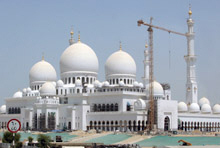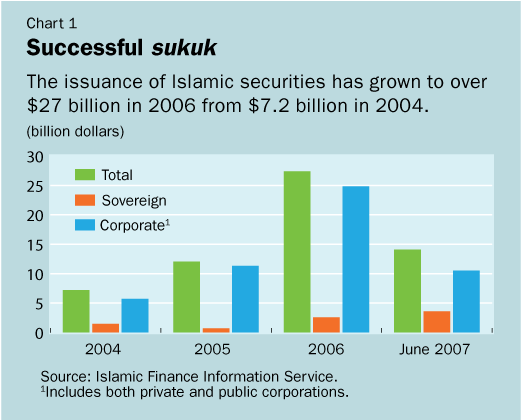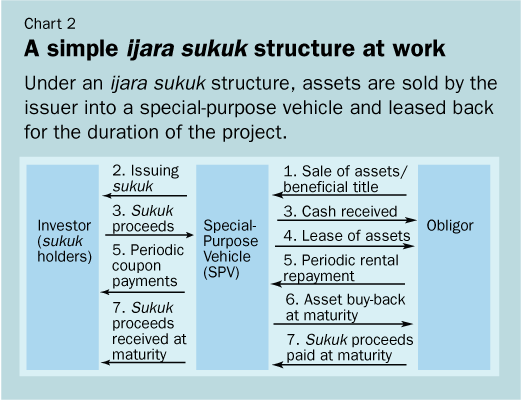
Typical street scene in Santa Ana, El Salvador. (Photo: iStock)
IMF Survey: Islamic Finance Expanding Rapidly
September 19, 2007
- Issuance of Islamic securities
- (sukuk)
- rose fourfold to $27 billion during 2004-06
- Sukuk
- tapped to diversify investor base, deepen domestic capital markets
- Harmonization of standards and practices will further boost popularity
The market for Islamic financial instruments is thriving.

Mosque in Abu Dhabi: Gulf Cooperation Council countries are a center for Islamic securities (photo: Karim Sahib/AFP)
SHARIAH-COMPLIANT SECURITIES
Awash with liquidity, thanks to the ongoing oil boom, Islamic financial institutions are increasingly eyeing investments that are compliant with Islamic law (Shariah) to accommodate their excess capital.
Similarly, hedge funds and conventional institutional investors have increasingly been drawn to Islamic securities in search for yield pickup and diversification. This has resulted in a flurry of Islamic securitization transactions, with the issuance of sukuk (non-interest-bearing securities based on Islamic principles) quadrupling to over $27 billion in 2006 from $7.2 billion in 2004 (see Chart 1).

Adhering to principles
Among the various forms of securitization in Islamic finance, the most popular is commonly referred to as sukuk. These instruments operate similarly to conventional asset-backed securities but are structured to ensure compliance with Islamic finance principles, which, among other provisions, prohibit the receipt and payment of interest and stipulate that income must be derived as profits from shared business risk rather than guaranteed return. As such, Islamic principles require sukuk investors to own the underlying asset via a special purposes vehicle (SPV), which funds payments to investors from direct investment in real, religiously sanctioned economic activity.
While 14 types of sukuk are recognized by the Accounting and Auditing Organization of Islamic Finance Institutions, their structure relies on one of the three basic forms of legitimate Islamic finance, murabahah (synthetic loans/purchase orders), musharakah/mudharabah (profit-sharing arrangements), and ijara (sale-leasebacks), or a combination thereof.
A simple example of such a securitization—in this case ijara, which is typically associated with leasing projects (usually equipment or real estate)—is depicted in Chart 2: assets are sold by the issuer into a special-purpose vehicle and leased back for the duration of the project.

When the notes mature, the obligor buys back the asset. The acceptance of these Islamic investment structures has considerably contributed toward the development of local capital markets.
The big players
Sukuk issuance has been concentrated in parts of Asia and countries of the Gulf Cooperation Council (GCC)—Bahrain, Kuwait, Oman, Qatar, Saudi Arabia, and the United Arab Emirates. There, the development of the sukuk market has been facilitated by sovereign benchmark issues that have been growing strongly (up 40 percent in the first six months of 2007 compared to 2006 as a whole). In value terms, about half of these issues originate in Asia (primarily Malaysia and also Brunei) and the other half in the GCC.
Corporate issuance—both public and private—has also expanded rapidly, doubling both between 2004-05 (from $5.7 billion to $11.3 billion) and 2005-06 (from $11.3 billion to $24.8 billion). While Asia (specifically Malaysia) accounted for the bulk of all Shariah-compliant corporate issues in 2004 (close to 90 percent), issuance in the GCC has picked up rapidly and now accounts for close to half of all issues in the marketplace.
Many corporate issues—particularly large ones—are quasi-sovereign and as such are seen to benefit from an implicit sovereign guarantee. Thus, although these issues may be linked to an underlying asset, investor appetite may be driven primarily by the sovereign nature of the risk. It also helps to explain successful large scale placements that have been made in recent years, including two Dubai-based issues of $3.5 billion in 2006. Currently, the top five originators, including the Malaysian government, Nucleus Avenue of Malaysia, and Nakheel Development of UAE, represent more than 40 percent of global sukuk issuance.
"In the absence of conventional securitization in many Islamic countries, sukuk issuance will remain a favored structured finance funding option in these markets."
While there may be a cyclical element of current demand stemming from high oil revenues in the GCC, this demand supplements a long-term upswing in demand for Shariah-compliant securities from Islamic institutional investors. And, in the absence of conventional securitization in many Islamic countries, sukuk issuance will remain a favored structured finance funding option in these markets. In addition, hedge funds and conventional investment institutions are beginning to hold sukuk for purposes of either yield pickup or diversification.
Outside Asia and the GCC, the demand for sukuk has been limited, but they are beginning to gain popularity. The German State of Saxony-Anhalt was the first sovereign obligor to issue a sukuk in a non-Islamic jurisdiction, and several corporate sukuk were issued in the United Kingdom and the United States in recent years. The World Bank also issued its first local currency-denominated 760 million Malaysian ringgit ($200 million) sukuk in 2005.
Room to grow
The current level of sukuk issuance remains a fraction of the issuance of either conventional bonds or asset-backed securities in emerging markets. But a growing number of countries are considering tapping the sukuk market to diversify their investor base and deepen domestic capital markets.
In this context, the IMF is receiving a growing number of requests for technical advice as part of its expanded work on sovereign liability risk management and capital market development, and has advised member countries on sukuk issuance as an alternative to more traditional financing instruments. This increase in demand, along with the standardization of Islamic securities, is expected to fuel further growth of the sukuk market. According to recent market reports, governments and corporates are expected to issue over $30 billion in sukuk annually over the next three years, which would lift the market size of sukuk to more than $150 billion.
Overcoming obstacles
Despite the strong potential for the sukuk market, as is the case with any evolving securitization market, a number of economic, legal, and regulatory challenges remain, irrespective of Shariah compliance (see research). These include the substitution of standard structural features in conventional securities, such as credit enhancements, which are not normally contractually permissible in the Islamic context; legal uncertainty arising from the fact that the transaction structure needs to satisfy commercial as well as Islamic law, in particular in non-Islamic countries; and, regulatory differences between national regulators.
Ongoing efforts by key Islamic regulators—notably the Accounting and Auditing Organization for Islamic Financial Institutions, the International Islamic Financial Market, and the Islamic Financial Services Board—to facilitate harmonization of standards and practices should help overcome some of these teething pains.
Further reading:
| Title | Author | Date | Series |
|
Sole, Juan |
July 1, 2007 |
Working Paper No. 07/175 | |
|
Bonato, Leo |
May 1, 2007 |
Working Paper No. 07/119 | |
|
Jobst, Andreas |
May 1, 2007 |
Working Paper No. 07/117 | |
|
Monetary Operations and Government Debt Management Under Islamic Banking |
Sundararajan, Vasudevan; Marston, David; Shabsigh, Ghiath |
September 1, 1998 |
Working Paper No. 98/144 |
|
The Design of Instruments for Government Finance in an Islamic Economy |
Ul Haque, Nadeem; Mirakhor, Abbas |
April 1, 1998 |
Working Paper No. 98/54 |
|
Islamic Banking - Issues in Prudential Regulations and Supervision |
Errico, Luca; Farahbaksh, Mitra |
March 1, 1998 |
Working Paper No. 98/30 |
|
Khan, Mohsin S.; Mirakhor, Abbas |
September 18, 1991 |
Working Paper No. 91/88 | |
|
Mohammed El Qorchi |
December 2005 |
Finance & Development Volume 42, Number 4 | |
|
Zamir Iqbal |
June 1997 |
Finance & Development Volume 34, Number 2 |


